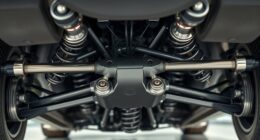To source OEM service information, you should build strong relationships with manufacturers or authorized dealers. Clearly communicate your maintenance needs and explore support programs or licensing options they offer. Sometimes, access is restricted to protect proprietary data, so negotiating and demonstrating your client status or certification can improve your chances. Knowing OEM policies and available support plans helps you get the right manuals, guides, and updates, so keep exploring these strategies for better support and equipment reliability.
Key Takeaways
- Establish relationships with OEM representatives or authorized distributors to gain access to technical manuals and service data.
- Explore OEM support programs, licensing, or subscription services designed for fleet operators or certified repair facilities.
- Negotiate directly with OEMs by clearly communicating maintenance needs and demonstrating your support requirements.
- Leverage industry partnerships or certifications to improve your negotiation position for accessing proprietary information.
- Utilize aftermarket support resources that provide authorized manuals, troubleshooting guides, and software updates for OEM equipment.

Are you struggling to find reliable OEM service information for your equipment? If so, you’re not alone. Accessing accurate and comprehensive OEM service data is essential for maintenance, repairs, and guaranteeing your machinery runs smoothly. One key aspect to consider is the aftermarket support provided by OEMs and how it influences your ability to get the information you need. Manufacturers that offer robust aftermarket support typically provide detailed manuals, troubleshooting guides, and software updates, making it easier for technicians and operators to perform necessary work. When OEMs prioritize aftermarket support, they recognize that keeping their clients satisfied with accessible service information benefits their reputation and long-term business.
Reliable OEM service info is vital; strong aftermarket support ensures easier access to manuals, updates, and troubleshooting guides.
However, obtaining this support isn’t always straightforward. Many OEMs restrict access to certain service details to protect their proprietary technology or to encourage you to go through authorized channels. This is where supplier negotiations come into play. Negotiating effectively with suppliers can open access to essential service information, especially if you establish a good relationship with them. Demonstrating your commitment to proper maintenance and your need for reliable data can motivate OEMs or authorized distributors to provide you with the technical manuals, parts catalogs, or diagnostic tools you require. Building a solid rapport and clearly communicating your needs can sometimes lead to better aftermarket support, including exclusive access to updated information or specialized training.
Furthermore, understanding your rights and the OEM’s policies helps during negotiations. Some manufacturers have programs or partnerships that facilitate easier access to service information for certain clients, such as fleet operators or certified repair facilities. Knowing these options allows you to leverage your position, whether you’re negotiating for better terms or seeking direct support. Don’t hesitate to ask about available support plans, licensing agreements, or subscription services that may grant you ongoing access to OEM data. In many cases, investing in these services can save you time and money by reducing downtime and preventing costly mistakes. Additionally, familiarizing yourself with the Dog breeds and their unique characteristics can sometimes assist in understanding the specific needs or maintenance routines for specialized equipment or tools associated with certain breeds.
Ultimately, sourcing OEM service information boils down to understanding the value of aftermarket support and approaching supplier negotiations with confidence. Clear communication, building strong relationships, and being aware of your rights can markedly improve your access to vital technical data. This proactive approach not only streamlines your maintenance processes but also guarantees your equipment operates at peak performance. With the right negotiation strategies and support from OEMs, you’ll be better equipped to maintain your machinery efficiently and effectively.
Frequently Asked Questions
How Do I Verify the Authenticity of OEM Service Information?
You verify the authenticity of OEM service information by checking manufacturer verification. Confirm the data comes directly from the official manufacturer’s website or authorized sources. Look for digital signatures or secure certificates that confirm data authenticity. Contact the manufacturer if you’re unsure. Avoid third-party sites that may provide outdated or false information. Confirming the source and verifying digital markers helps guarantee you’re working with genuine, reliable OEM service data.
What Are the Costs Associated With Sourcing OEM Service Data?
Think of sourcing OEM service data like buying concert tickets—prices vary based on the seller and seat. You might encounter pricing models such as subscriptions or one-time fees, while data access fees can range from affordable to premium, depending on the manufacturer. Costs depend on your needs, with some OEMs charging for detailed technical information, so it’s crucial to compare options and budget accordingly to access the info you require.
Are There Legal Restrictions on Using OEM Service Information?
You should be aware that using OEM service information can be limited by legal restrictions, mainly due to intellectual property rights and licensing restrictions. These rights mean you might need permission or licensing agreements to use the data lawfully. If you ignore these restrictions, you risk legal action or penalties. Always ensure you have the proper authorization before accessing or using OEM service information to stay compliant with applicable laws.
How Frequently Is OEM Service Information Updated?
OEM service information is updated regularly, often aligning with maintenance schedules and software updates. You should check with the manufacturer’s official channels or authorized service providers to stay current, as updates can occur monthly or quarterly. Staying informed guarantees you have the latest troubleshooting procedures and software patches, helping you maintain essential vehicle performance and safety. Regular updates are vital for accurate diagnostics and effective repairs.
Can Third-Party Providers Supply OEM Service Data Legally?
Yes, third-party providers can supply OEM service data legally if they have proper licensing agreements. You should seek aftermarket solutions that operate within legal boundaries to guarantee compliance. These providers obtain OEM data through licensing, which allows them to distribute the information legitimately. Always verify that any third-party source has the necessary permissions, so you avoid legal issues and access accurate, up-to-date OEM service information.
Conclusion
So, after all that hunting for OEM service info, you might think you’ll finally crack the code. But surprise—sometimes, the harder you try, the more elusive it becomes. It’s almost poetic how the best-kept secrets hide just out of reach, isn’t it? Keep digging, stay persistent, and enjoy the irony that the very details you chase are often the hardest to find. After all, isn’t that what makes the search so exciting?









